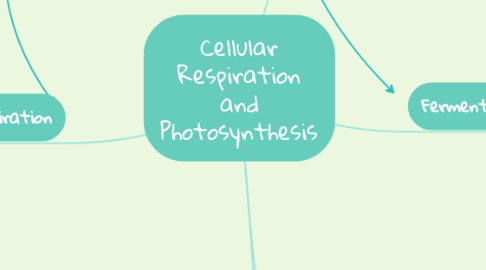
1. The amount of energy produced during cellular respiration is much more than fermentation.
2. Cellular Respiration
2.1. Stage 1
2.1.1. Does NOT require oxygen
2.1.2. Takes place in the cytoplasm
2.1.3. Produces...
2.1.3.1. A little energy (2 ATP)
2.1.3.2. Water (H20)
2.1.3.3. Carbon dioxide (CO2)
2.1.4. Molecules of glucose are broken down into simpler molecules.
2.2. Stage 2
2.2.1. Does require oxygen
2.2.2. Takes place in the mitochondria
2.2.3. Produces...
2.2.3.1. lots of energy (36 ATP)
2.2.3.2. Water (H2O)
2.2.3.3. Carbon Dioxide (CO2)
2.2.4. The molecules are broken down even more.
2.3. The process of breaking down glucose into energy using oxygen.
2.4. 6O2 + C6H12O6 === 6H20 + 6CO2 + energy
3. Photosynthesis
3.1. Stage 1
3.1.1. Chloroplasts capture the sun's energy.
3.1.2. Chlorophyll is the main pigment found in plants. Pigments are colored chemical compounds that absorb light.
3.2. Stage 2
3.2.1. Using that captured energy, plants convert CO2 (captured through the stomata) and H20 (sucked in through the roots) into glucose.
3.2.2. Stomata are small openings on the underside of a plant's leaves
3.3. The process that plants use to capture energy from sunlight and convert it into food.
3.4. 6CO2 + 6H2O ====== (sunlight) 6O2 + C6H12O6
4. Fermentation
4.1. Alchoholic Fermentation
4.1.1. Produces...
4.1.1.1. Energy
4.1.1.2. Carbon dioxide (CO2)
4.1.1.3. Water (H20)
4.1.1.4. Alchohol
4.1.2. Takes place in...
4.1.2.1. Plant cells
4.1.2.2. Bacteria cells
4.1.3. Helps...
4.1.3.1. Brewers
4.1.3.2. Bakers
4.2. Lactic Acid Fermentation
4.2.1. Produces...
4.2.1.1. Energy
4.2.1.2. Carbon Dioxide (CO2)
4.2.1.3. Water (H2O)
4.2.1.4. Lactic acid
4.2.2. Takes place in...
4.2.2.1. Animal cells
4.2.3. Helps...
4.2.3.1. build muscles
